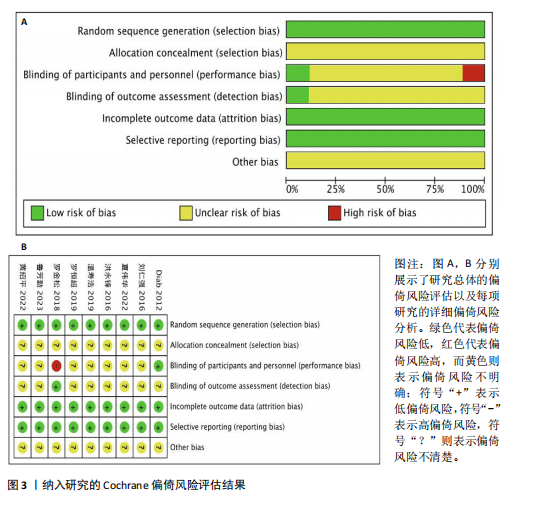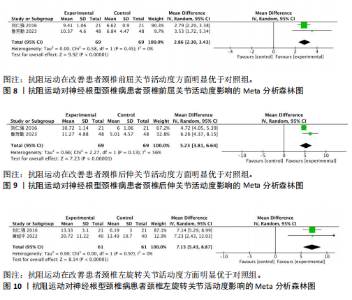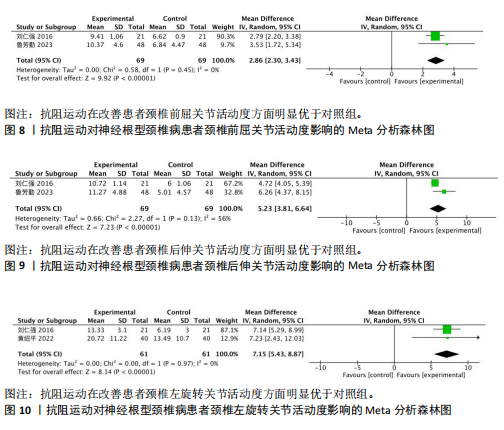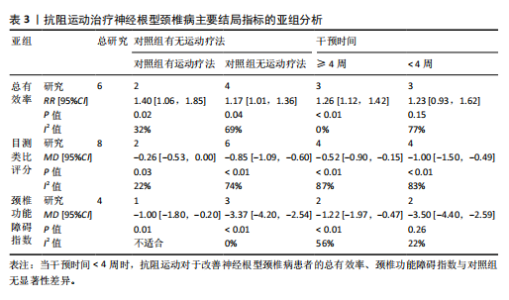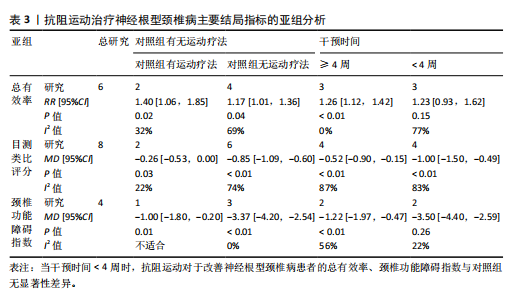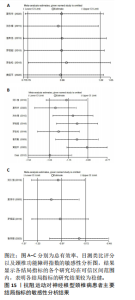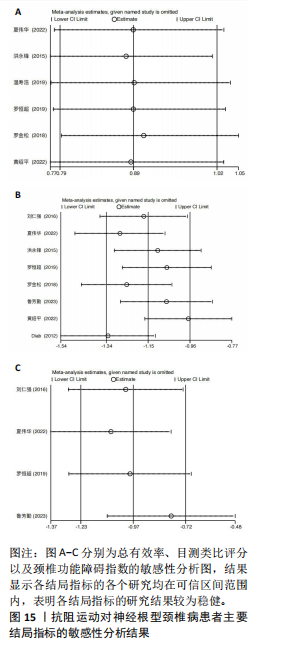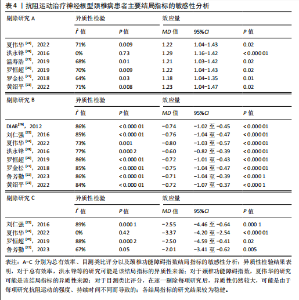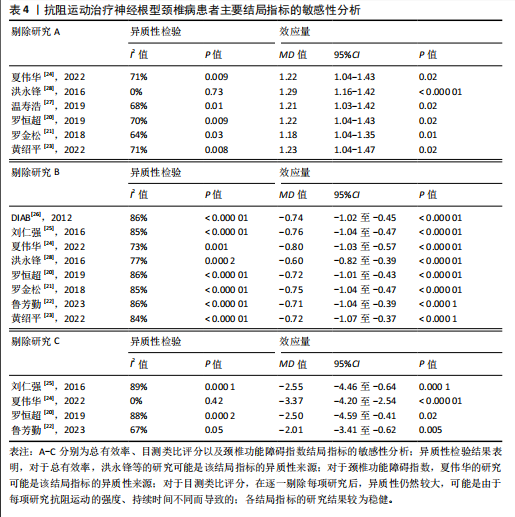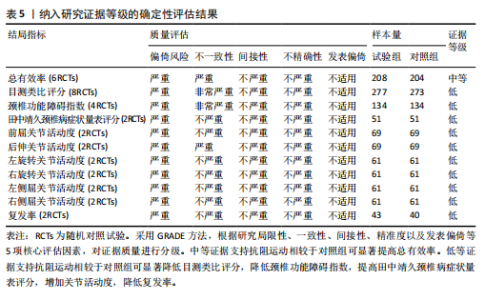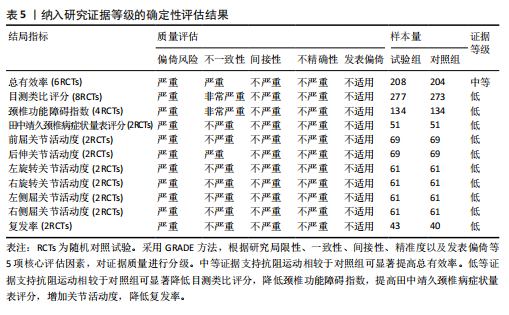Chinese Journal of Tissue Engineering Research ›› 2026, Vol. 30 ›› Issue (4): 987-996.doi: 10.12307/2026.529
Previous Articles Next Articles
Effects of resistance exercise therapy on pain and function in patients with cervical spondylotic radiculopathy: a meta-analysis
Li Hanyue1, Li Yini2, Xiang Linmei3, Li Sen4
- 1College of Physical Education, Southwest Medical University, Luzhou 646000, Sichuan Province, China; 2Department of Ultrasound, 3Department of Dermatology, Affiliated Hospital of Southwest Medical University, Luzhou 646000, Sichuan Province, China; 4Nanjing Drum Tower Hospital, Nanjing University Medical School, Nanjing 210000, Jiangsu Province, China
-
Received:2024-12-11Accepted:2025-01-21Online:2026-02-08Published:2025-05-21 -
Contact:Li Sen, MD, Chief physician, Master’s supervisor, Nanjing Drum Tower Hospital, Nanjing University Medical School, Nanjing 210000, Jiangsu Province, China -
About author:Li Hanyue, Master candidate, College of Physical Education, Southwest Medical University, Luzhou 646000, Sichuan Province, China -
Supported by:Sichuan Provincial Science and Technology Program, No. 2022NSFSC0688 (to LS); Southwest Medical University Applied Basic Research Program, No. 2021ZKMS050 (to LS)
CLC Number:
Cite this article
Li Hanyue, Li Yini, Xiang Linmei, Li Sen. Effects of resistance exercise therapy on pain and function in patients with cervical spondylotic radiculopathy: a meta-analysis[J]. Chinese Journal of Tissue Engineering Research, 2026, 30(4): 987-996.
share this article
Add to citation manager EndNote|Reference Manager|ProCite|BibTeX|RefWorks
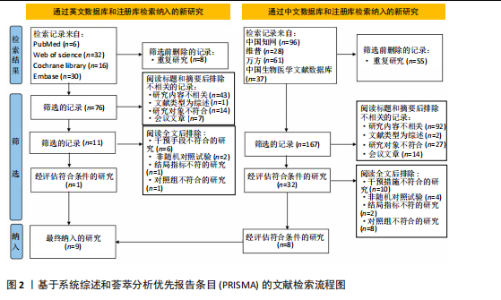
2.1 检索结果和文献筛选 经过对数据库的检索,初步筛选出文献共计306篇。在去除重复文献63篇后,通过阅读剩余文献的标题和摘要,进一步剔除了200篇文献,最终得到43篇文献。对这些文献进行全文阅读,并依据纳入及排除标准进行评估后,剔除了34篇文献,最终确定纳入9篇文献[20-28],见图2。 2.2 纳入研究的基本特征 经过筛选,共有9篇文献符合纳入及排除标准,涉及患者总数为672例,其中试验组主要采取抗阻运动作为干预手段,而对照组则接受除抗阻运动之外的其他保守治疗,具体信息见表1。6项研究报告了总有效率[20-21,23-24,27-28],8项研究报告了目测类比评分[20-26,28],4项研究报告了颈部功能障碍指数[20,22,24-25],2项研究报告了田中靖久颈椎病症状量表评分[24-25],2项研究报告了颈椎前屈后伸关节活动度[22,25],2项研究报告了颈椎左右旋转、左右侧屈关节活动度[23,25],2项研究报告了复发率[25,28]。 2.3 纳入文献方法学质量评价结果 依据Cochrane偏倚风险评估工具,纳入的9篇文献全部采用了随机方法,所有文献均未提到是否进行分配隐藏措施;其中1篇文献采用盲法[26],1篇文献报道了盲法的高风险[21],1篇文献结局指标评估者进行盲法评估[21];所有文献均无选择性报告或数据不完整且均未提到其他偏倚来源,结果见图3。依据物理治疗证据数据库量表评分标准,8篇纳入文献整体质量较高,集中在6-7分[20-25,27-28],1篇文献为高质量文献[26],物理治疗证据数据库量表评分结果见表2。 2.4 Meta分析结果 2.4.1 总有效率 纳入的6项研究报道了总有效率,共412名受试者[20-21,23-24,27-28]。如图4显示,异质性检验为P=0.01,I2=66%,Meta分析"
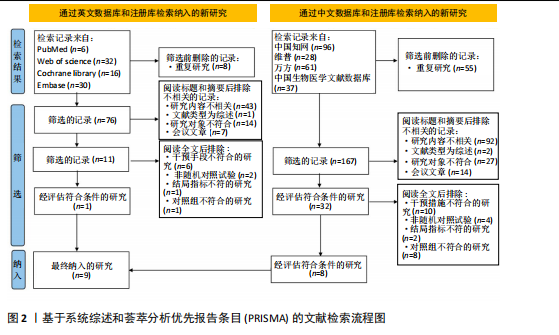
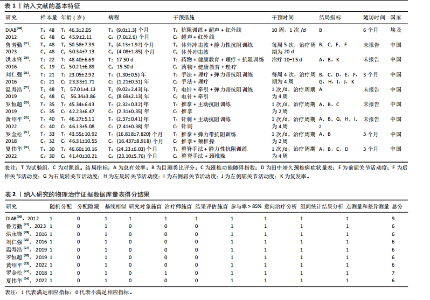
结果显示:与对照组相比,抗阻运动可显著提高神经根型颈椎病患者的总有效率(RR=1.22,95%CI=1.06-1.41,P=0.005)。 2.4.2 目测类比评分 纳入的8项研究报道了目测类比评分,共550例患者[20-26,28]。如图5显示,异质性检验为P < 0.000 01,I2=84%,Meta分析结果显示:与对照组相比,抗阻运动能够显著降低神经根型颈椎病患者的目测类比评分(MD=-0.72,95%CI= -0.98至-0.46,P < 0.000 01)。 2.4.3 颈椎功能障碍指数 纳入的4项研究报道了颈椎功能障碍指数,共268例患者[20,22,24-25]。如图6显示,异质性检验为P=0.000 4,I2=83%,Meta分析结果显示:与对照组相比,抗阻运动能够显著降低神经根"

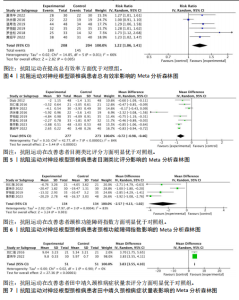
型颈椎病患者的颈椎功能障碍指数(MD=-2.57,95%CI=-4.13至-1.02,P=0.001)。 2.4.4 田中靖久颈椎病症状量表评分 纳入的2项研究报道了田中靖久颈椎病症状量表评分,共102例患者[24-25]。如图7显示,异质性检验为P=0.90,I2=0%,Meta分析结果显示:与对照组相比,抗阻运动能够显著改善患者的田中靖久颈椎病症状量表评 分(MD=3.83,95%CI=3.55-4.10,P < 0.000 01)。 2.4.5 关节活动度 (1)前屈关节活动度:纳入的2项研究报道了颈椎前屈关节活动度,共138例患者[22,25]。如图8显示,异质性检验为P=0.45,I2=0%;Meta分析结果显示:与对照组相比,抗阻运动能够显著改善患者颈椎前屈关节活动度(MD=2.86,95%CI=2.30-3.43,P < 0.000 01)。 (2) 后伸关节活动度:纳入的2项研究报道了颈椎后伸关节活动度,共138例患者[22,25]。如图9显示,异质性检验为P=0.13,I2=56%;Meta分析结果显示:抗阻运动能够显著改善患者颈椎后伸关节活动度(MD= 5.23,95%CI=3.81-6.64,P < 0.000 01)。 (3)左旋转关节活动度:纳入的2项研究报道了颈椎左旋转关节活动度,共122例患者[23,25]。如图10显示,异质性检验为P=0.97,I2=0%;Meta分析结果显示:与对照组相比,抗阻运动能够显著改善患者颈椎左旋转关节活动度(MD=7.15,95%CI=5.43-8.87,P < 0.000 01)。 (4)右旋转关节活动度:纳入的2项研究报道了颈椎右旋转关节活动度,共122例患者[23,25]。如图11显示,异质性检验为P=0.98,I2=0%;Meta分析结果显示:与对照组相比,抗阻运动能够显著改善患者颈椎右旋转关节活动度(MD=5.45,95%CI=3.59-7.31,P < 0.000 01)。 (5)左侧屈关节活动度:纳入的2项研究报道了颈椎左侧屈关节活动度,共122例患者[23,25]。如图12显示,异质性检验为P=0.18,I2=44%,Meta分析结果显示:与对照组相比,抗阻运动能够显著改善患者颈椎左侧屈关节活动度(MD=3.35,95%CI=1.98-4.72,P < 0.000 01)。 (6)右侧屈关节活动度:纳入的2项研究报道了颈椎右侧屈关节活动度,共122例患者[23,25]。如图13显示,异质性检验为P=0.19,I2=41%, Meta分析结果显示:与对照组相比,抗阻运动能够显著改善患者颈椎右侧屈关节活动度(MD=3.91,95%CI=2.65-5.17,P < 0.000 01)。 2.4.6 复发率 纳入的2项研究报道了复发率,共83例患者[25,28]。如图14显示,异质性检验为P=0.43,I2=0%,Meta分析结果显示:与对照组相比,抗阻运动能够显著降低神经根型颈椎病患者的复发率(RR=0.22,95%CI=0.06-0.80,P=0.02)。 2.5 亚组分析 为进一步揭示主要结局指标的稳健性以及可能的异质性来源,根据以下方面进行亚组分析:①对照组的干预措施;②试验组的抗阻运动干预时间。见表3。"
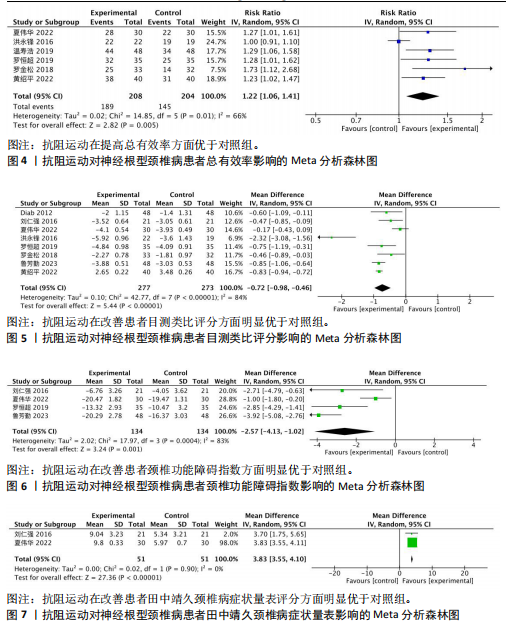
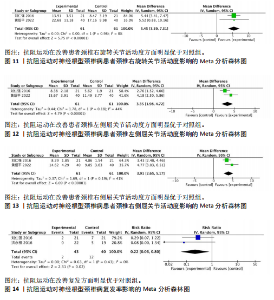
2.6 发表偏倚评价 根据《Cochrane干预措施系统评价手册》的规定,只有当纳入的文献数量超过10篇时,方可采用漏斗图对研究进行发表偏倚的评估。若纳入文献数量不足,可能会因文献数量过少而无法准确判断漏斗图检验的有效性及对称性的真实性。鉴于此研究纳入的随机对照试验中,所有结局指标的分析文献均未达到10篇,因此未进行发表偏倚的漏斗图分析。 2.7 敏感性分析 为检验单篇文献对主要结局指标总体效应量的影响,并探究主要结局指标异质性的可能来源,该研究进行了敏感性分析。分析结果表明:在总有效率、目测类比评分、颈椎功能障碍指数方面,所有纳入文献均未对总体效应量产生显著影响,总体效应量结果较稳健。然而,洪永锋等[28]的研究可能构成总有效率异质性的来源;对于颈椎功能障碍指数,夏伟华[24]的研究可能是异质性来源。在目测类比评分方面,敏感性分析后研究间的高异质性未见明显变化,这提示导致目测类比评分高异质性的因素可能是多方面且复杂的,见图15,表4。 2.8 证据等级 相关结果的等级证据见表5。中等证据支持抗阻运动相较于对照组可显著提高总有效率。低等证据支持抗阻运动相较于对照组可显著降低目测类比评分、颈椎功能障碍指数,提高田中靖久颈椎病症状量表评分,增加关节活动度,降低复发率。"
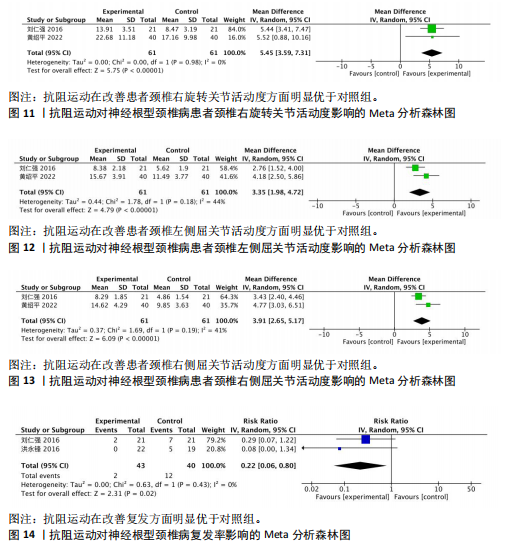
| [1] ENGEBRETSEN KB, TASO M, BJORLAND S, et al. A functional intervention within a cognitive approach to chronic cervical radiculopathy : Description of the non-surgical treatment arm in a randomised controlled trial evaluating the effectiveness of surgery. BMC Musculoskelet Disord. 2024;25(1):629. [2] RAFIQ S, ZAFAR H, GILLANI SA, et al. Comparison of neural mobilization and conservative treatment on pain, range of motion, and disability in cervical radiculopathy: A randomized controlled trial. PLoS One. 2022;17(12):e0278177. [3] BORRELLA-ANDRÉS S, MARQUÉS-GARCÍA I, LUCHA-LÓPEZ MO, et al. Manual Therapy as a Management of Cervical Radiculopathy: A Systematic Review. Biomed Res Int. 2021; 2021:9936981. [4] TASO M, SOMMERNES JH, KOLSTAD F, et al. A randomised controlled trial comparing the effectiveness of surgical and nonsurgical treatment for cervical radiculopathy. BMC Musculoskelet Disord. 2020;21(1):171. [5] BONO CM, GHISELLI G, GILBERT TJ, et al. An evidence-based clinical guideline for the diagnosis and treatment of cervical radiculopathy from degenerative disorders. Spine J. 2011;11(1):64-72. [6] KJAER P, KONGSTED A, HARTVIGSEN J, et al. National clinical guidelines for non-surgical treatment of patients with recent onset neck pain or cervical radiculopathy. Eur Spine J. 2017;26(9):2242-2257. [7] GROSS AR, LEE H, EZZO J, et al. Massage for neck pain. Cochrane Database Syst Rev. 2024;2(2):CD004871. [8] HASSAN F, OSAMA M, GHAFOOR A, et al. Effects of oscillatory mobilization as compared to sustained stretch mobilization in the management of cervical radiculopathy: A randomized controlled trial. J Back Musculoskelet Rehabil. 2020; 33(1):153-158. [9] AKKAN H, GELECEK N. The effect of stabilization exercise training on pain and functional status in patients with cervical radiculopathy. J Back Musculoskelet Rehabil. 2018;31(2):247-252. [10] CHAVES TS, SCARPELLI MC, BERGAMASCO JGA, et al. Effects of Resistance Training Overload Progression Protocols on Strength and Muscle Mass. Int J Sports Med. 2024; 45(7):504-510. [11] CHENG CH, TSAI LC, CHUNG HC, et al. Exercise training for non-operative and post-operative patient with cervical radiculopathy: a literature review. J Phys Ther Sci. 2015;27(9):3011-3018. [12] YOUNG IA, MICHENER LA, CLELAND JA, et al. Manual therapy, exercise, and traction for patients with cervical radiculopathy: a randomized clinical trial. Phys Ther. 2009; 89(7):632-642. [13] BUKHARI SR, SHAKIL-UR-REHMAN S, AHMAD S, et al. Comparison between effectiveness of Mechanical and Manual Traction combined with mobilization and exercise therapy in Patients with Cervical Radiculopathy. Pak J Med Sci. 2016;32(1): 31-34. [14] DAI W, WANG X, XIE R, et al. Baduanjin exercise for cervical spondylotic radiculopathy: A protocol for systematic review and meta-analysis. Medicine (Baltimore). 2020;99(18):e0037s. [15] KUIJPER B, TANS JT, BEELEN A, et al. Cervical collar or physiotherapy versus wait and see policy for recent onset cervical radiculopathy: randomised trial. BMJ. 2009; 339:b3883. [16] LIN LH, LIN TY, CHANG KV, et al. Pain neuroscience education for reducing pain and kinesiophobia in patients with chronic neck pain: A systematic review and meta-analysis of randomized controlled trials. Eur J Pain. 2024;28(2):231-243. [17] PAGE MJ, MCKENZIE JE, BOSSUYT PM, et al. The PRISMA 2020 statement: An updated guideline for reporting systematic reviews. Int J Surg. 2021;88:105906. [18] SHEA BJ, REEVES BC, WELLS G, et al. AMSTAR 2: a critical appraisal tool for systematic reviews that include randomised or non-randomised studies of healthcare interventions, or both. BMJ. 2017;358:j4008. [19] 《骨科疾病疗效评价标准》出版[J].实用骨科杂志,2012,18(8):691. [20] 罗恒超.主动抗阻运动疗法治疗神经根型颈椎病的临床应用[J].颈腰痛杂志, 2019,40(1):99-100. [21] 罗金松.推拿结合抗阻力训练对神经根型颈椎病患者生活质量影响的临床观察[D].昆明:云南中医学院,2018. [22] 鲁芳勤,刘涛杰,刘懿欣,等.静力性抗阻训练联合体外冲击波治疗神经根型颈椎病的疗效观察[J].颈腰痛杂志,2023, 44(5):811-813. [23] 黄绍平.颈三针联合主动抗阻运动治疗神经根型颈椎病临床观察[J].实用中医药杂志,2022,38(8):1421-1423. [24] 夏伟华.整脊手法结合静力性抗阻训练对神经根型颈椎病康复作用分析[D].南宁:广西中医药大学,2022. [25] 刘仁强.按摩配合功能锻炼对神经根型颈椎病康复疗效的分析[D].武汉:华中师范大学,2016. [26] DIAB AA, MOUSTAFA IM. The efficacy of forward head correction on nerve root function and pain in cervical spondylotic radiculopathy: a randomized trial. Clin Rehabil. 2012;26(4):351-361. [27] 温寿浩.针灸牵引结合颈椎运动疗法治疗神经根型颈椎病提高疗效及生活质量的运用[J].中医临床研究,2019,11(5): 107-109. [28] 洪永锋,吴建贤,刘奕,等.颈部及患侧上肢强化肌力训练对神经根型颈椎病疗效的影响[J].中国实用神经疾病杂志, 2016,19(21):27-30. [29] OWEN PJ, MILLER CT, MUNDELL NL, et al. Which specific modes of exercise training are most effective for treating low back pain? Network meta-analysis. Br J Sports Med. 2020;54(21):1279-1287. [30] RASMUSSEN-BARR E, HALVORSEN M, BOHMAN T, et al. Summarizing the effects of different exercise types in chronic neck pain - a systematic review and meta-analysis of systematic reviews. BMC Musculoskelet Disord. 2023;24(1):806. [31] RHIM HC, KIM SJ, PARK J, et al. Effect of citrulline on post-exercise rating of perceived exertion, muscle soreness, and blood lactate levels: A systematic review and meta-analysis. J Sport Health Sci. 2020; 9(6):553-561. [32] TATARYN N, SIMAS V, CATTERALL T, et al. Posterior-Chain Resistance Training Compared to General Exercise and Walking Programmes for the Treatment of Chronic Low Back Pain in the General Population: A Systematic Review and Meta-Analysis. Sports Med Open. 2021;7(1):17. [33] LIMA LV, ABNER TSS, SLUKA KA. Does exercise increase or decrease pain? Central mechanisms underlying these two phenomena. J Physiol. 2017;595(13):4141-4150. [34] STOLZMAN S, BEMENT MH. Does Exercise Decrease Pain via Conditioned Pain Modulation in Adolescents? Pediatr Phys Ther. 2016;28(4):470-473. [35] DAILEY DL, KEFFALA VJ, SLUKA KA. Do cognitive and physical fatigue tasks enhance pain, cognitive fatigue, and physical fatigue in people with fibromyalgia? Arthritis Care Res (Hoboken). 2015;67(2):288-296. [36] BUCKNER SL, DANKEL SJ, MATTOCKS KT, et al. Differentiating swelling and hypertrophy through indirect assessment of muscle damage in untrained men following repeated bouts of resistance exercise. Eur J Appl Physiol. 2017;117(1):213-224. [37] SLEIJSER-KOEHORST MLS, COPPIETERS MW, EPPING R, et al. Diagnostic accuracy of patient interview items and clinical tests for cervical radiculopathy. Physiotherapy. 2021;111:74-82. [38] MUELLER J, WEINIG J, NIEDERER D, et al. Resistance, Motor Control, and Mindfulness-Based Exercises Are Effective for Treating Chronic Nonspecific Neck Pain: A Systematic Review With Meta-Analysis and Dose-Response Meta-Regression. J Orthop Sports Phys Ther. 2023;53(8): 420-459. |
| [1] | Li Haojing, Wang Xin, Song Chenglin, Zhang Shengnan, Chen Yunxin. Therapeutic efficacy of extracorporeal shock wave therapy in the upper trapezius muscle area combined with exercise control training in patients with chronic non-specific neck pain [J]. Chinese Journal of Tissue Engineering Research, 2026, 30(5): 1162-1170. |
| [2] | Zheng Yin, Wu Zhenhua, Zhang Cheng, Ruan Kexin, Gang Xiaolin, Ji Hong. Safety and efficacy of immunoadsorption therapy for rheumatoid arthritis: a network meta-analysis and systematic review [J]. Chinese Journal of Tissue Engineering Research, 2026, 30(5): 1260-1268. |
| [3] | Chen Qiang, Wu Wenjuan, Jiang Shuhua, Huang Da. Physical exercise improves physical function in burn patients: a systematic review and meta-analysis [J]. Chinese Journal of Tissue Engineering Research, 2026, 30(5): 1269-1281. |
| [4] | Leng Xiaoxuan, Zhao Yuxin, Liu Xihua. Effects of different neuromodulatory stimulation modalities on non-motor symptoms in Parkinson’s patients: a network meta-analysis [J]. Chinese Journal of Tissue Engineering Research, 2026, 30(5): 1282-1293. |
| [5] | Wen Xiaolong, Weng Xiquan, Feng Yao, Cao Wenyan, Liu Yuqian, Wang Haitao. Effects of inflammation on serum hepcidin and iron metabolism related parameters in patients with type 2 diabetes mellitus: a meta-analysis [J]. Chinese Journal of Tissue Engineering Research, 2026, 30(5): 1294-1301. |
| [6] | Zhou Jian, Zhang Tao, Zhou Weili, Zhao Xingcheng, Wang Jun, Shen Jie, Qian Li, Lu Ming. Effects of resistance training on quadriceps mass and knee joint function in patients with osteoporosis and sarcopenia [J]. Chinese Journal of Tissue Engineering Research, 2026, 30(5): 1081-1088. |
| [7] | Jiang Yang, Peng Hao, Song Yanping, Yao Na, Song Yueyu, Yin Xingxiao, Li Yanqi, Chen Qigang. Isometric exercise reduces resting blood pressure: a meta-analysis of moderating factors and dose effects [J]. Chinese Journal of Tissue Engineering Research, 2026, 30(4): 975-986. |
| [8] | Sun Jiahe, Shi Jipeng, Zhu Tianrui, Quan Helong, Xu Hongqi. Effect of exercise intervention in elderly individuals with sarcopenia and its comorbidities: a meta-analysis [J]. Chinese Journal of Tissue Engineering Research, 2026, 30(4): 997-1007. |
| [9] | Yang Yuanyuan, Zhou Shanshan, Cheng Xiaofei, Feng Luye, Tang Jiqin. Network meta-analysis of non-invasive brain stimulation in the treatment of lower limb motor dysfunction after stroke [J]. Chinese Journal of Tissue Engineering Research, 2026, 30(4): 1008-1018. |
| [10] | Zhou Feng, Fu Pengfei, Qian Yufan, Xu Pingcheng, Guo Jiongjiong, Zhang Lei. Correlation between spinal sagittal imbalance and knee joint parameters detected by whole-body EOS imaging [J]. Chinese Journal of Tissue Engineering Research, 2026, 30(3): 596-603. |
| [11] | Yang Peng, Xu Chenghan, Zhou Yingjie, Chai Xubin, Zhuo Hanjie, Li Lin, Shi Jinyu. A meta-analysis of risk factors for residual back pain after vertebral augmentation for osteoporotic vertebral compression fractures [J]. Chinese Journal of Tissue Engineering Research, 2026, 30(3): 731-739. |
| [12] | Zhang Anqi, Hua Haotian, Cai Tianyuan, Wang Zicheng, Meng Zhuo, Zhan Xiaoqian, Chen Guoqian . Pain after total knee arthroplasty: current status and trend analysis [J]. Chinese Journal of Tissue Engineering Research, 2026, 30(3): 795-804. |
| [13] | Zhang Xinxin, Gao Ke, Xie Shidong, Tuo Haowen, Jing Feiyue, Liu Weiguo. Network meta-analysis of non-surgical treatments for foot and ankle ability and dynamic balance in patients with chronic ankle instability [J]. Chinese Journal of Tissue Engineering Research, 2025, 29(9): 1931-1944. |
| [14] | Sun Yundi, Cheng Lulu, Wan Haili, Chang Ying, Xiong Wenjuan, Xia Yuan. Effect of neuromuscular exercise for knee osteoarthritis pain and function: a meta-analysis [J]. Chinese Journal of Tissue Engineering Research, 2025, 29(9): 1945-1952. |
| [15] | Wang Yida, Liu Jun, Wang Xiaoling, Wang Liyan, Yang Chengru, Zhang Xuexiao. Effects of wearable electronic device-based interventions on physical activity and sedentary behavior in healthy adolescents: a meta-analysis [J]. Chinese Journal of Tissue Engineering Research, 2025, 29(8): 1693-1704. |
| Viewed | ||||||
|
Full text |
|
|||||
|
Abstract |
|
|||||

